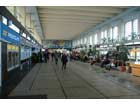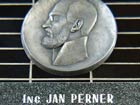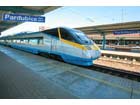Tourism/Transport/Czech Rails
History
The industrial revolution in the Czech Lands starting at the beginning of 19th century considerably affected the development of transportation; firstly the road network was created, and railways started to be used to transport material. The so-called horse-drawn rail line that was built between České Budějovice and Linz in 1856 – 1835 to transport salt started to be used first, and subsequently the second line that served to transport wood from the area around Křivoklát to Prague was put into operation. Development of railway transport rapidly continued, the steam engine railway started to develop and the Austrian monarchy was interested in connecting important seats of its state. In the early 1840s the general headquarters of the state railways was established; it immediately began preparing two projects. The first one included construction of the Southern State Railway between Triest and Vienna, the other one was the then Northern State Railway connecting Vienna and Prague. There were several options considered, and the route which would be most feasible technically and financially, was being sought. Although a strong group of supporters of a direct railway line from Prague to Brno had appeared, the railway line from Prague to Olomouc, evaluated by the office as the fastest with regard to journey time and the most economical, and at the same time the connecting line from Brno to Česká Třebová began to be built on 4th September 1842. Construction works both on the line itself and on railway buildings along it advanced rapidly. Railway construction approached Pardubice a year later, the winter in 1843 interrupted the work till April 1844, then the construction continued from Vystrkov (Slovany today). As for terrain alterations, planes around the Chrudimka river had to be straightened out and a bridge had to be built across the river between Moravany and Pardubice. In the spring of 1845 work finished on the railway and trial operation could begin. A train arrived in Pardubice for the first time during the test run on 26th June 1845. The new railway was officially opened two months later. Half an hour before noon on 20th August 1845, a festively decorated train welcomed by artillery salvos, triumphal arches and crowds of people living in the town and near surroundings came to the railway station in Pardubice. After a short welcoming speech pronounced by the top representatives of the town light refreshments were offered to the delegation which included, among other people, Austrian archduke František Karel and duke Josef of the Hungarian empire. Then the train drawn by two locomotives called Prag and Olmütz and led by a separate locomotive driven by Ing. Jan Perner started to move towards Prague, where it arrived at half past four p.m. It is only Ing. Jan Perner that is closely connected with the railway construction in the section from Pardubice to Prague; later he was also charged with the route from Choceň to Pardubice, which ultimately became fatal for him on 9th September 1845. Nine days after regular passenger transport commenced on the line from Prague to Olomouc, the chief engineer Perner was checking the technical condition of the route in the direction from Choceň and due to an unlucky coincidence of circumstances he suffered a head injury, as a result of which he died the next day, in his parents’ house in Pardubice – the Valcha mill which is known even today.
The building of Pardubice railway station was allocated a place not far from the road leading to Chrudim to the west of the point of its intersection with the railway line and where the underpass from the 17th November avenue to Jan Palach’s street is located now. The station consisted of a complex of buildings the construction of which was commenced in August 1844. The chief engineer Jüngling submitted a project for its construction to Vienna for approval in April of the same year. The station had one main rail and three minor transport rails; this number ranked it among second-class stations. Fleischmann and brothers, a construction company, won the tender for construction of the station hall and managed to build up a one-storey brick admission building in the middle of the station in a very short period of time; there were offices, a railway and postal forwarding office, flat, hall with a cash-desk on the ground floor and three company-owned flats on the first floor. A long ground-floor building with a covered loading ramp with offices and a flat for the stock manager led from the admission hall along the main rail axis. On the other side, across the rails, a locomotive shed for eight machines was built and various workshops were attached to its – locksmith’s, blacksmith’s, joiner’s shop. But passengers did not use this railway building for a long time The railways continued to develop in Pardubice and lines in other directions were built gradually. In 1854 a commission started preparation of the line towards Hradec Králové, the construction itself was commenced in mid-September 1856, the railway bridge across the Elbe river between Pardubice and Rosice was completed in April 1857 and the first test run was carried out on 1st November of the same year. The line was extended up to Liberec at Christmas in 1858 and the test run was performed on 29 January 1859. At that time a new railway station was under construction, which was festively opened together with the new line on 14th April 1859 and regular operation on the line from Pardubice to Liberec then began in early May. The old railway station building was converted into an accommodation block and is the seat of ČD Telematika at present (ČD = Czech Railways). The new railway station was already the seat of two companies operating individual railway lines but the building did not cope with increasing operational requirements in the years to come and it was therefore reconstructed essentially in the Neo-Baroque style in the period from 1906 to 1908. It served its purposes then – after minor alterations caused by air raids in 1944 till the end of 1950s when new premises built in 1947 – 1957 and used until now were completed. It is a rather valued structure in the Functionalist style from the post-war period; Karel Řepa was the author of its plans.
Railway connections with towns in a southerly direction, i.e. with Chrudim and also with Havlíčkův (then Německý) Brod were the last to be completed; construction itself began in the summer of 1870 and the railway operation on the line from Pardubice to Německý Brod commenced as soon as 16th May 1871. At that moment Pardubice became an important railway junction having decisive influence on further development of the town. At the end of the 19th century, Pardubice acquired the title of the largest town in eastern Bohemia through establishing companies near the railway station and creating suitable working conditions for its inhabitants.
Current period
The Pardubice railway station is an important transport hub of national importance ensuring:
- direct international connection to Warsaw, Moscow, Košice, Žilina, Vienna, Hamburg
- international connection with a change in Prague (100 km from Pardubice) to Vienna, Linz, Venice, Rome, Munich, Frankfurt upon Main, Nuremberg, Cologne, Dortmund, Dresden, Leipzig, Hamburg, Berlin, Paris, Zurich, Bern, Budapest, Warsaw
- intra-state direct connection with Prague, Děčín, Cheb, Pilsen, Liberec, Hradec Králové, Brno, Přerov, Olomouc, Ostrava
- cargo transport terminal including the service of collection and delivery of goods from house to house
- container terminal also including the service of collection and delivery of goods from house to house
- ČD courier
Near the railway station, passengers may change to municipal public and intercity bus transportation. Furthermore a taxi rank is outside the railway station building.
www.cd.cz
Train departures www.vlak.cz/ConnForm.asp?p=CD
ČD courier www.cd.cz/index.php?action=section&id=29655
Pendolino www.scpendolino.cz


.jpg)
.jpg)
.jpg)


.jpg)
.jpg)
.jpg)